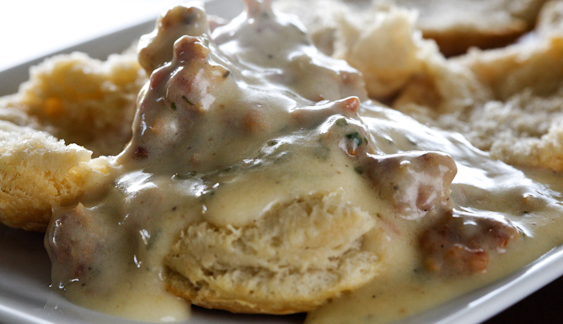Sausage Gravy from the Fancy Gap

introduction
Sausage gravy is everywhere these days, gliding over split biscuits from Bojangles’ to Bob Evans. Nice see to an old favorite in play. But we all know that when fast food jumps on a regional American classic, authenticity is out of the running and flavor pouches are not far away. As a matter of fact, really bad sausage gravy is already pandemic: we’ve eaten umpteen versions of it ladled on crumbly, baking-powder biscuits in little places all over. Sausage gravy isn’t high cuisine—in fact, its mother, milk gravy, was a child of pan drippin’s and poverty. But sometimes the easiest things to make are the easiest to screw up.
Great sausage gravy requires immaculate ingredients—and occasionally elusive conditions—to be perfect. You start with fine breakfast sausage, fatty and flavorful, a big pinch of flour, fresh whole milk, a little sprinkle of fresh herbs, and lots of black pepper. Oh, and some nice meaty drippings to give the dish gusto. Not many people keep pan drippings on the back of their stoves these days. So we use stock instead—chicken or beef, whatever you like, but it must be flavorful, concentrated, and homemade. The stock add-on is arguably apocryphal because the beauty of sausage gravy is its “git ’er done delivery.” But without pan drippings you need something. And stock is our best offer. (You probably have some frozen, right?)
If most sausage gravy looks gray, sludgy, and warmed over, that’s because it has been made carelessly, with indifferent ingredients, hours earlier. Sausage gravy is not meant to be steam-table fare: it is, in essence, a pan sauce.
Of course, sausage gravy’s most important accessory would be the biscuits—and here we’ve got you covered. Our Don’t Call Me Angel Biscuits are crispy-crunchy on the bottom and top, and tender-buttery in the middle. They don’t crumb-up or go all gluey when the gravy hits them, and they don’t sting your tongue with taste of baking powder—because they’re made with yeast.
As for the “elusive conditions” mentioned above: according to my husband, Glenn, Anson Mills founder, the best sausage gravy and biscuits appear when you drive a hot-loaded, 18-wheel rig on a cold rainy night from Raleigh, North Carolina, straight up Route 52. You arrive at the Fancy Gap truck stop high on the Appalachian range around 1:30 a.m. You hit the safety brakes, jump from the cab into driving sleet, and run into the diner. The cook, who has been there for years, gives you scalding coffee and hot, split biscuits made from flour milled right down the road. She ladles steaming, velvety milk gravy flush with fresh, farmstead sausage over the biscuits. It’s the best thing on earth. It is 1971.
Guess you had to be here.
equipment mise en place
For this recipe, you will need a large skillet, a wooden spoon, a slotted spoon, paper towels, and a whisk.
-
-
1pound bulk breakfast sausage, as good-quality as you can find
-
1tablespoon unsalted butter
-
3tablespoons unbleached all-purpose flour
-
1¼cups hot, rich, homemade stock, such as our Smoked Ham and Chicken Stock
-
1cup whole milk, plus additional to thin the gravy, if needed
-
1tablespoon minced fresh sage
-
1teaspoon minced fresh thyme
-
Fine sea salt and freshly ground black pepper
-
Tabasco
-
-
Place the sausage in a large skillet and cook over medium-low heat, breaking it up with a wooden spoon, until the sausage is crisp and brown and the fat has rendered, 10 to 15 minutes. Using a slotted spoon, transfer the sausage from the skillet to a stack of folded paper towels to drain.
-
Pour off all but 1 tablespoon of fat from the skillet. To this fat, add the butter and melt over low heat. Add the flour into the fat and cook until golden, stirring constantly, 2 to 3 minutes. Pour in the hot stock in a steady stream and whisk until the flour and butter are blended into the stock. Stir in the milk. Increase the heat to medium-high and bring the gravy to a simmer. Simmer for 5 minutes, or until the gravy is the consistency you like.
-
Return the sausage to the skillet, add the herbs, and simmer until the sausage is heated through and the flavors in the gravy have blended. If the gravy is thicker than you like, add a little milk. Season to taste with salt, freshly ground black pepper, and a few drops of Tabasco.